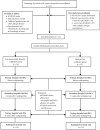Effects of Indoor Air Pollutants on Atopic Dermatitis
- PMID: 27941696
- PMCID: PMC5201361
- DOI: 10.3390/ijerph13121220
Effects of Indoor Air Pollutants on Atopic Dermatitis
Abstract
The increasing prevalence of atopic dermatitis (AD) is associated with variations in indoor environments. In Korea, many inner walls of homes are covered with wallpaper: such walls emit indoor air pollutants, including volatile organic compounds (VOCs) and formaldehyde. This randomized, double-blind study investigated the effects of wallpaper on indoor air quality and AD. Thirty-one children (aged three to eight years) with moderate AD were assigned to environmentally-friendly (EF) and polyvinyl chloride (PVC) wallpaper groups. Indoor air concentrations of VOCs, natural VOCs (NVOCs), formaldehyde, and total suspended bacteria were measured before and two (W₂) and eight weeks (W₈) after wallpapering. Scoring Atopic Dermatitis (SCORAD) evaluations and blood tests were performed during the same period. The EF wallpaper and PVC wallpaper groups showed similar trends in the changes in total VOCs (TVOC) and formaldehyde content in the indoor air. However, the EF wallpaper group showed more improvement on the SCORAD at W₂ and W₈ than the PVC wallpaper group. The SCORAD index was positively correlated with several indoor air pollutants. Further, the SCORAD index and NVOC % were negatively correlated. Improved SCORAD index and effects of wallpapering on indoor air quality improvements occurred within a short period of time in both groups. We believe that NVOCs in indoor air after EF wallpapering have a beneficial effect on health.
Keywords: VOCs; air pollution; atopic; dermatitis; formaldehyde; indoor.
Conflict of interest statement
The authors declare no conflict of interest.
Figures
Similar articles
-
Airborne concentrations of volatile organic compounds, formaldehyde and ammonia in Finnish office buildings with suspected indoor air problems.J Occup Environ Hyg. 2009 Mar;6(3):200-9. doi: 10.1080/15459620802707835. J Occup Environ Hyg. 2009. PMID: 19152165
-
Indoor levels of volatile organic compounds and formaldehyde from emission sources at elderly care centers in Korea.PLoS One. 2018 Jun 7;13(6):e0197495. doi: 10.1371/journal.pone.0197495. eCollection 2018. PLoS One. 2018. PMID: 29879122 Free PMC article.
-
Formaldehyde and volatile organic compounds in Hong Kong homes: concentrations and impact factors.Indoor Air. 2009 Jun;19(3):206-17. doi: 10.1111/j.1600-0668.2008.00580.x. Epub 2009 Feb 7. Indoor Air. 2009. PMID: 19220507
-
The role of air pollutants in atopic dermatitis.J Allergy Clin Immunol. 2014 Nov;134(5):993-9; discussion 1000. doi: 10.1016/j.jaci.2014.09.023. Epub 2014 Nov 5. J Allergy Clin Immunol. 2014. PMID: 25439225 Review.
-
An overview of health hazards of volatile organic compounds regulated as indoor air pollutants.Rev Environ Health. 2019 Mar 26;34(1):81-89. doi: 10.1515/reveh-2018-0046. Rev Environ Health. 2019. PMID: 30854833 Review.
Cited by
-
Impact of Environmental Factors on the Prevalence Changes of Allergic Diseases in Elementary School Students in Ulsan, Korea: A Longitudinal Study.Int J Environ Res Public Health. 2020 Nov 27;17(23):8831. doi: 10.3390/ijerph17238831. Int J Environ Res Public Health. 2020. PMID: 33261111 Free PMC article.
-
The clinical, mechanistic, and social impacts of air pollution on atopic dermatitis.J Allergy Clin Immunol. 2024 Oct;154(4):861-873. doi: 10.1016/j.jaci.2024.07.027. Epub 2024 Aug 14. J Allergy Clin Immunol. 2024. PMID: 39151477 Review.
-
Personal Exposure to Total VOC Is Associated With Symptoms of Atopic Dermatitis in Schoolchildren.J Korean Med Sci. 2022 Feb 28;37(8):e63. doi: 10.3346/jkms.2022.37.e63. J Korean Med Sci. 2022. PMID: 35226421 Free PMC article.
-
Exposure to Volatile Organic Compounds May Contribute to Atopic Dermatitis in Adults.Biomedicines. 2024 Jun 26;12(7):1419. doi: 10.3390/biomedicines12071419. Biomedicines. 2024. PMID: 39061993 Free PMC article.
-
Mechanism and Influence Factors of Abrasion Resistance of High-Flow Grade SEBS/PP Blended Thermoplastic Elastomer.Polymers (Basel). 2022 Apr 28;14(9):1795. doi: 10.3390/polym14091795. Polymers (Basel). 2022. PMID: 35566968 Free PMC article.
References
-
- Lee H., Shin S., Oh J. New patterns of childhood asthma prevalence in six Asian countries: Comparison of ISAAC phases I and III. Pediatr. Allergy Respir. Dis. 2008;18:70–77.
-
- Ahn K., Kim J., Kwon H., Chae Y., Hahm M., Lee K., Park Y.M., Lee S., Han M., Kim W.K. The prevalence of symptoms of asthma, allergic rhinoconjunctivitis, and eczema in Korean children: Nationwide cross-sectional survey using complex sampling design. J. Korean Med. Assoc. 2011;54:769–778. doi: 10.5124/jkma.2011.54.7.769. - DOI
Publication types
MeSH terms
Substances
LinkOut - more resources
Full Text Sources
Other Literature Sources
Medical


